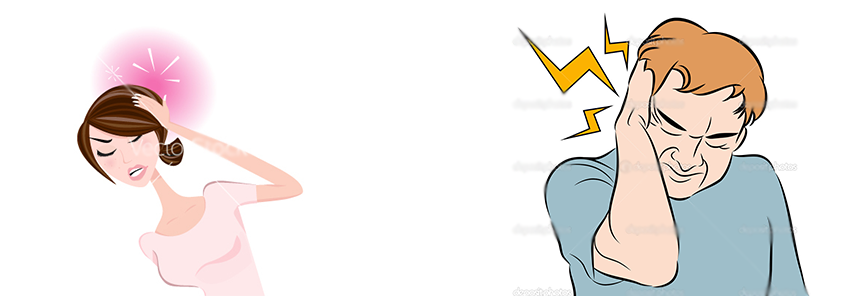Headache

Headache
Headache is pain felt in any region of the head upto upper part of the neck . Brain itself is pain insensitive, but surrounding structures like coverings of brain, arteries and muscles are pain sensitive. Stimulation of these pain sensitive areas from inflammation and irritation results in headache. Headache may be sharp pain, dull ache or throbbing sensation and may occur on one or both sides, front or back of the head.
Headache may be primary or secondary.
Primary headache results from overactivity of pain sensitive areas and there is no underlying structural problem. Examples: Migraine headache, tension headache and cluster headache.
Secondary headaches are due to disease conditions that causes inflammation of meninges or artery and cause pain. This group also includes headache caused by substance abuse, overuse of medication ( rebound headache) and pain referred from surrounding structures.
Common Causes/Types of Headache
Primary Headache
- Tension headache: It is most common type of primary headache. Although the exact cause of tension headache is not know it is thought to be caused by muscular strains in the region of head and neck brought on by emotional stress. A heightened sensitivity to pain and stress is thought to explain the association with stress (the most common trigger) and headache. The intensity of headache vary but usually is not disabling. It is felt in the back of the head and neck but may become diffuse and feel like band like sensation around the head. Muscles of scalp, neck and shoulder may become tender to touch. Physical activity doesn’t make tension headache worse and is not associated with nausea,vomiting and photophobia which distinguishes it from migraine. Tension headache can be episodic or chronic.
- Migraine: It is the second most common cause of primary headache. Pain is usually moderate to severe and can be disabling. It is characterized by repeated one sided pulsating, throbbing headaches with nausea and vomiting and extreme sensitivity to light and sound. Symptoms last hours to days. Some people experience warning symptoms called aura before pain. More common in women and tends to run in families. Exact cause is not known but genetics and environmental factors play a role. Imbalance of brain chemical called serotonin is thought to play a role.
- Cluster headaches: It is the least common but the severest form of headache. Occurs in clusters, over weeks or even months characterized by pain in one side of the head and behind the eyes. Pain is so intense that patient can’t sit still without pacing during the attack. Congested or runny nose, watery, red eyes occur during pain attack (typically on the side of headache). The etiology of the cluster headaches is unknown, but smoking is a risk factor and alcohol is a trigger.
Secondary Headache
- Infection: of brain (encephalitis), its covering (meningitis), brain abscess, neuro cysticercosis (pork tapeworm).
- Brain tumor
- Stroke or brain attack
- Subarachnoid (space between coverings of brain) hemorrhage
- Upper respiratory tract infections: like sinusitis causing referred headache.
- Eye problems such as glaucoma, refractive errors
- Medication induced: nitrates, calcium channel blockers (Nifedipine)
- Head injury
- Hypertensive emergency
- Inflammation of blood vessels- Temporal artery (Giant cell arteritis)
- Idiopathic intracranial hypertension
- Psychiatric conditions: anxiety, stressful conditions
- Any serious systemic disease or symptoms (like fever) may cause headache
When to visit the Doctor?
Seek medical advice or consult the doctor if headache is accompanied by:
- Fainting, confusion, difficulty in speaking
- Sudden severe headache or change in character of previous headache
- Difficult to concentrate or in performing daily activity
- High fever i.e. greater than 102 0F
- Weakness or paralysis arm, leg or face
- Neck stiffness (rigidity)
- Pregnancy
- Head injury
- Visual loss
- Vomiting with or without fever
- Headache with systemic disease like cancer, HIV or taking medicine that suppress immune system (steroids, anticancer)
Treatment Options
History and Physical examination along with CT scan or MRI of brain or Lumbar puncture (to examine fluid around brain and spinal cord) may be needed for the diagnosis. A referral to specialist (Neurologist, Eye specialist) may be necessary.
Migraine headaches are treated with the following methods:
- Analgesics – Acetaminophen/paracetamol or Non steroidal anti inflammatory drugs like Ibuprofen or Naproxen are used for acute migraine.
- Triptans (Sumatriptan) are considered more specific for migraine headache.
- Antiemetics by injections can be used as adjunctive treatment for acute migraine.
- Prevention of migraine: by avoiding triggers, lifestyle changes (sleep hygiene) and medications (Beta blockers, calcium channel blockers, antidepressants or anticonvulsants).
Tension type headache:
- Acute treatment with Acetaminophen/paracetamol or Non steroidal anti inflammatory drugs like Ibuprofen or Naproxen.
- Preventive treatment: Tricyclic antidepressant (Amitriptyline) or anticonvulsants (Gabapentin)
Cluster Headache:
- 100% oxygen and Sumatriptan (subcutaneous injection) are first line treatment
- Preventive therapy: Verapamil is drug of choice.
Secondary headaches are treated according to cause e.g. antibiotics for bacterial meningitis, sinusitis. Blood pressure control for hypertension. Surgery for brain abscess or brain tumor.
General measures: Proper hydration and adequate rest. Avoid stress, alcohol, tobacco or illicit drugs. Avoid excess use of over the counter pain medicines.



Send us your feedback on this article